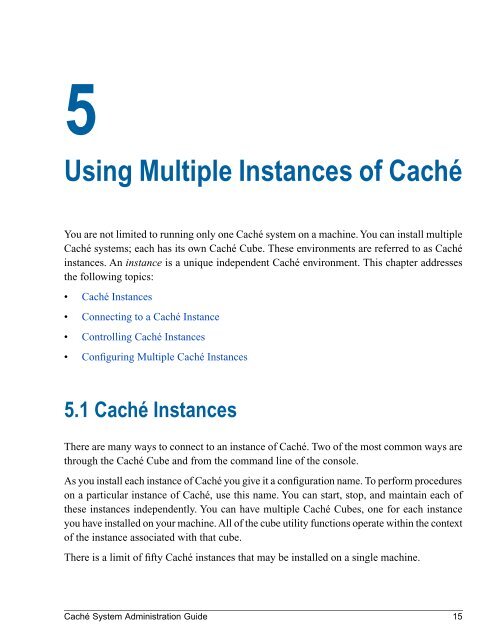Caché System Administration Guide - InterSystems Documentation
Caché System Administration Guide - InterSystems Documentation
Caché System Administration Guide - InterSystems Documentation
Create successful ePaper yourself
Turn your PDF publications into a flip-book with our unique Google optimized e-Paper software.
5Using Multiple Instances of <strong>Caché</strong>You are not limited to running only one <strong>Caché</strong> system on a machine. You can install multiple<strong>Caché</strong> systems; each has its own <strong>Caché</strong> Cube. These environments are referred to as <strong>Caché</strong>instances. An instance is a unique independent <strong>Caché</strong> environment. This chapter addressesthe following topics:• <strong>Caché</strong> Instances• Connecting to a <strong>Caché</strong> Instance• Controlling <strong>Caché</strong> Instances• Configuring Multiple <strong>Caché</strong> Instances5.1 <strong>Caché</strong> InstancesThere are many ways to connect to an instance of <strong>Caché</strong>. Two of the most common ways arethrough the <strong>Caché</strong> Cube and from the command line of the console.As you install each instance of <strong>Caché</strong> you give it a configuration name. To perform procedureson a particular instance of <strong>Caché</strong>, use this name. You can start, stop, and maintain each ofthese instances independently. You can have multiple <strong>Caché</strong> Cubes, one for each instanceyou have installed on your machine. All of the cube utility functions operate within the contextof the instance associated with that cube.There is a limit of fifty <strong>Caché</strong> instances that may be installed on a single machine.<strong>Caché</strong> <strong>System</strong> <strong>Administration</strong> <strong>Guide</strong> 15

















